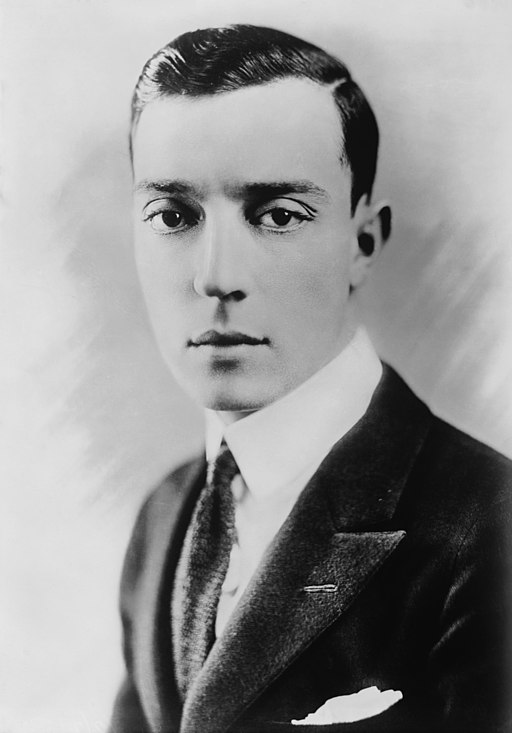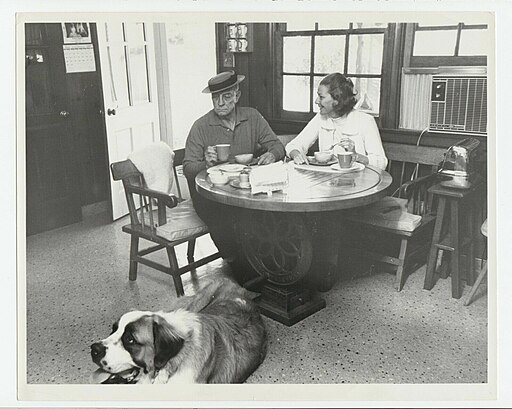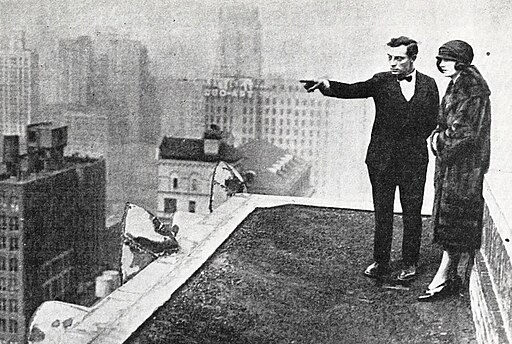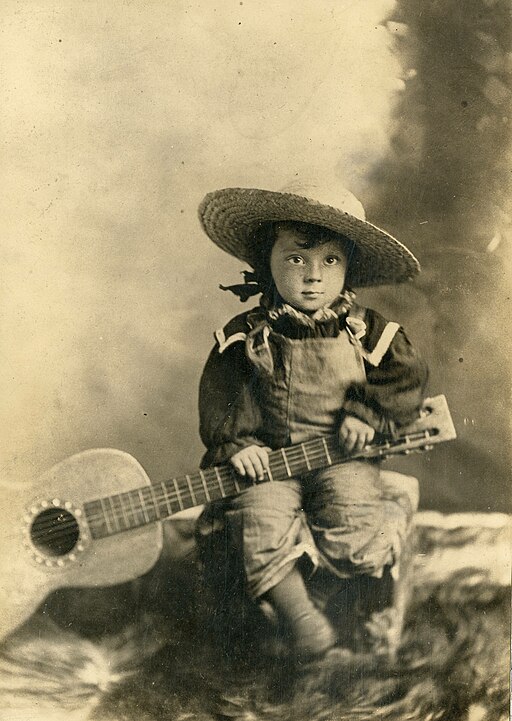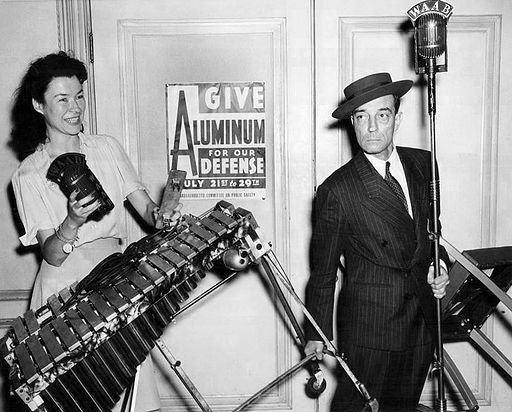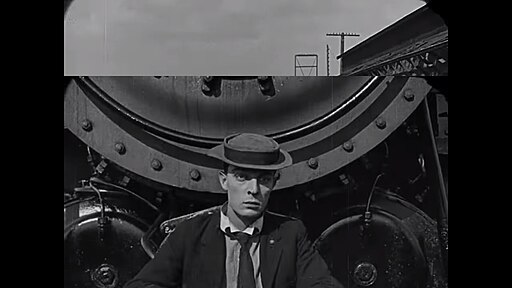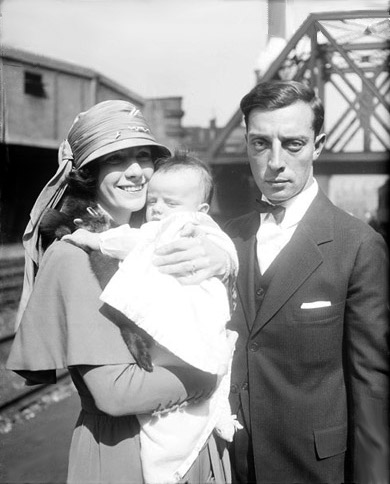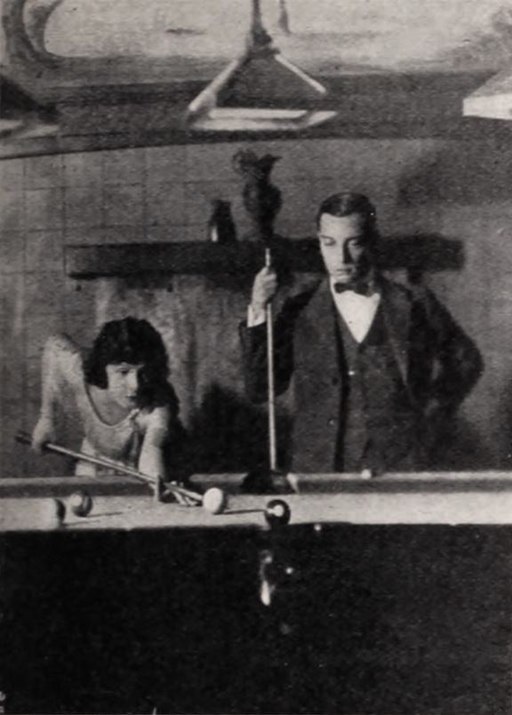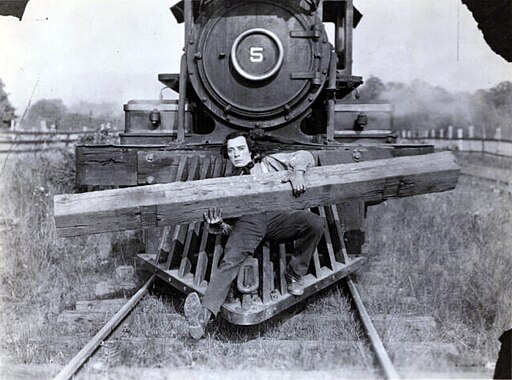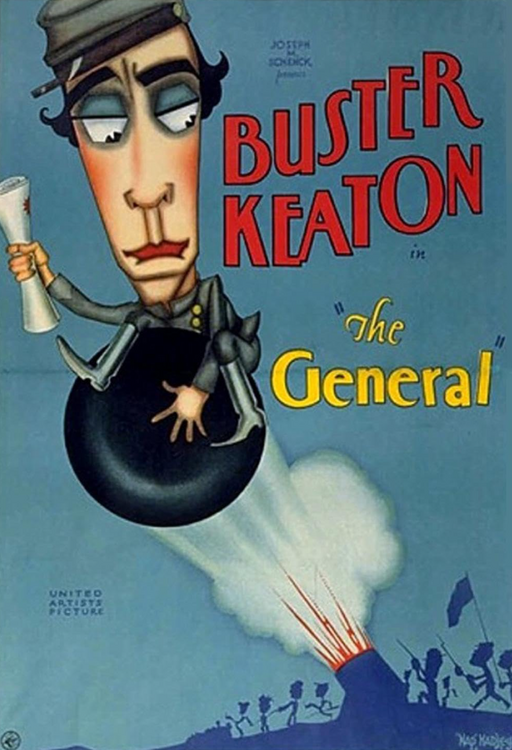Buster Keaton
back| Full Name | Joseph Frank Keaton VI |
| Stage Name | Buster Keaton |
| Born | October 4, 1895 |
| Birthplace | Piqua, Kansas, USA |
| Died | February 1, 1966 |
| Buried | Forest Lawn Memorial Park, Hollywood Hills, California, USA |
| Married to | Natalie Talmadge (1921–1932) - Mae Scriven (1933–1936) - Eleanor Norris (1940 until his death in 1966) |
| Children | Two sons with Natalie Talmadge: Joseph Keaton and Robert Keaton |
| Notable films | The General (1926) - Steamboat Bill. Jr. (1928) - Sherlock Jr. (1924) - The Navigator (1924) - Seven Changes (1925) |
Buster Keaton
The Great Stone Face
Buster Keaton's career spanned the silent and sound eras of film, but his most impactful work was done in the 1920s during the silent film era. Despite facing professional and personal challenges, including a decline in his career during the transition to sound films and struggles with alcoholism, Keaton's legacy as a pioneering figure in film comedy endures.
His work has been celebrated for its creativity, daring stunts, and the expressionless "Great Stone Face" that became his trademark. Keaton's influence is evident in the works of many filmmakers and performers who followed him.
Related
Buster Keaton (1895 – 1966)
Biography and Career Overview
Buster Keaton, born Joseph Frank Keaton VI on October 4, 1895, in Piqua, Kansas, embarked on a path that would lead him to become one of the most iconic figures in the silent film era. His journey through life was as dynamic and multifaceted as the stunts he performed on screen, marked by professional triumphs, personal challenges, and a legacy that continues to influence the world of comedy and filmmaking.
Early Years and Entry into Show Business
Keaton's entry into the world of entertainment was almost predestined, born into a vaudeville family. His father, Joe Keaton, and mother, Myra Keaton, were performers, and he made his stage debut as a toddler. The nickname "Buster" was supposedly given to him by Harry Houdini after witnessing a young Keaton tumble down a flight of stairs without injury. His childhood was unconventional, spent traveling with his family's act, "The Three Keatons," where he quickly became known for his physical comedy skills and the ability to take a fall without getting hurt.
Path Towards Success
Keaton's transition from vaudeville to film came in 1917 when he met Roscoe "Fatty" Arbuckle, who introduced him to the burgeoning world of silent cinema. It was in this medium that Keaton's distinctive blend of physical comedy, stoicism, and inventive filmmaking flourished. He possessed a natural talent for the craft, not just as an actor but as a director and editor, showcasing a genius for visual gags and a deep understanding of the mechanics of film.
Career Highs and Innovation
During the 1920s, Keaton's career soared. He created a series of silent shorts before moving on to feature films that would become classics, such as "The General," "Steamboat Bill, Jr.," and "Sherlock Jr." His films were marked by ambitious stunts, elaborate physical comedy, and a unique storytelling style. Keaton performed his own stunts, risking his life on numerous occasions for the perfect shot, exemplified by the iconic scene of a house facade falling around him in "Steamboat Bill, Jr."
Personal Life and Marriages
Off-screen, Keaton's personal life was filled with both joy and turmoil. He married Natalie Talmadge in 1921, and they had two sons, Joseph and Robert. The marriage, however, ended in divorce in 1932, partly due to Keaton's escalating alcoholism and the pressures of his declining career as the silent era waned and Hollywood transitioned to talkies. His career suffered under the control of MGM, and his personal life mirrored this decline. Keaton married Mae Scriven in 1933 in a union that lasted three years, and in 1940, he married Eleanor Norris, a stabilizing force in his life until his death.
Passions Beyond Film
Keaton's passions extended beyond the silver screen. He was an avid bridge player, a hobby that offered him solace during turbulent times. His love for baseball was well-known among his friends and colleagues, often organizing games on set. These interests provided a respite from the pressures of his career and personal life.
Later Years and Death
The revival of interest in silent films in the 1950s and 1960s brought Keaton's work back into the public eye, allowing him to enjoy a resurgence in popularity towards the end of his life. He appeared in television roles, commercials, and even made cameo appearances in films, including "A Funny Thing Happened on the Way to the Forum" (1966).
Buster Keaton passed away from lung cancer on February 1, 1966, in Woodland Hills, Los Angeles, California, leaving behind a legacy as one of the greatest comic minds and filmmakers of the silent film era. His work continues to inspire filmmakers, comedians, and audiences with its innovation, humor, and humanity.
Best of his Stunts:
Notable Movies Starring Buster Keaton:
Silent Era Feature Films
- "Three Ages" (1923): In this parody of D.W. Griffith's "Intolerance," Keaton plays a young man in love across three different historical periods: the Stone Age, Roman times, and modern America, showcasing his versatility and innovative storytelling.
- "Sherlock Jr." (1924): A film projectionist (Keaton) dreams of becoming a detective and magically enters the movie he is projecting, solving a crime in a series of ingenious and visually stunning sequences. This film is celebrated for its groundbreaking visual effects and inventive film techniques.
- "The Navigator" (1924): Keaton stars as a wealthy, clueless man who ends up stranded on a drifting ocean liner with a young woman. Their attempts to navigate the ship and survive are filled with inventive comedic setups and stunts.
- "Seven Chances" (1925): A man learns he will inherit a fortune if he marries by 7 p.m. that same day, leading to a frenetic chase as hundreds of would-be brides pursue him. It features some of Keaton's most elaborate and dangerous stunt work.
- "Go West" (1925): Keaton plays Friendless, a man who travels west to find fortune but instead forms an unlikely friendship with a cow named Brown Eyes. This film showcases Keaton's ability to blend emotion and comedy.
- "Battling Butler" (1926): This comedy features Keaton as Alfred Butler, a pampered rich man who is mistakenly thought to be a championship boxer, leading to a series of misunderstandings and physical comedy.
- "The General" (1926): Often cited as Keaton's masterpiece, this film features him as Johnnie Gray, who must rescue his beloved train and girlfriend from Union spies during the Civil War. It combines action, comedy, and romance, highlighted by Keaton's signature stunt work.
- "College" (1927): Keaton portrays a bookish college student who tries to win the heart of his love interest by excelling in athletics, with numerous comedic situations ensuing from his attempts at various sports.
- "Steamboat Bill, Jr." (1928): Known for the iconic scene of a house facade falling around Keaton, this film features him as the son of a steamboat captain, trying to prove his worth and win his love amidst a rivalry and a cyclone.
- "The Cameraman" (1928): In one of his final silent films, Keaton plays a man who attempts to become a newsreel cameraman to impress a woman. It's a blend of slapstick, romance, and a behind-the-scenes look at filmmaking.
Transition to Sound and Later Works
While Keaton's transition to sound films was challenging, he continued to work in the industry, appearing in both feature films and shorts. His creative control was significantly reduced during this period, and while none of these later films captured the genius of his silent work, they remain an essential part of his filmography.
- "Speak Easily" (1932): Keaton plays a timid professor who believes he has inherited a fortune and gets involved with a theater troupe, showcasing his comedic talent in the early sound era.
- "Limelight" (1952): In a supporting role alongside Charlie Chaplin (who also directed the film), Keaton delivers a memorable performance in this drama about a fading comedian, marking one of the few times the two silent film giants appeared together.
Analysis of Buster Keaton’s Style of Acting:
Buster Keaton's acting style, often encapsulated by his moniker "The Great Stone Face," is a remarkable blend of physical comedy, stoicism, and emotional subtlety, which set him apart from his contemporaries in silent film. His ability to convey complex emotions and situational humor without the use of speech or overt facial expressions created a unique screen presence that remains influential in the realm of film and comedy.
Physical Comedy and Stunt Work
Central to Keaton's acting style was his extraordinary physicality. He was not just an actor but a virtuoso physical comedian, capable of executing complex, dangerous stunts with precision and grace. Unlike many actors of his time and later, Keaton performed all his own stunts, contributing to the authenticity and comedic timing of his films. His background in vaudeville equipped him with a deep understanding of slapstick and physical humor, which he seamlessly translated to the screen. His stunts were not just for spectacle; they were intricately woven into the narrative, enhancing the humor and often advancing the plot.
Stoicism and "The Great Stone Face"
Keaton's stoic expression, earning him the nickname "The Great Stone Face," was another hallmark of his acting style. In contrast to the exaggerated gesticulations typical of silent film actors, Keaton maintained a deadpan expression, regardless of the chaos unfolding around him. This stoicism amplified the comedic effect of his physical antics and the absurdity of the situations his characters found themselves in. It also invited audiences to project their own feelings onto him, making his characters universally relatable.
Emotional Subtlety and Timing
Despite his stoic demeanor, Keaton was a master of conveying deep emotion through subtle gestures and timing. His performances often contained a layer of melancholy or vulnerability, which added depth to his characters and contrasted with the comedic turmoil surrounding them. This emotional depth distinguished his work from purely slapstick comedy, offering audiences a more nuanced and empathetic viewing experience.
Innovative Use of the Film Medium
Keaton's acting cannot be fully appreciated without acknowledging his innovative use of the film medium. He was a pioneer in exploring the possibilities of cinema, using camera angles, editing techniques, and visual effects to enhance his comedic style. Keaton had an instinctive understanding of the rhythm and timing of film, often using these elements to create jokes that were not just about what happened on screen, but how and when it was shown. His acting was thus inseparable from his directorial vision, making him a true auteur of his time.
Legacy
Buster Keaton's acting style has had a lasting impact on the worlds of comedy and cinema. His ability to blend physical comedy with a poignant emotional undertone, all while maintaining a stoic facade, has inspired generations of actors and filmmakers. Keaton's work transcends the silent film era, offering timeless insights into the human condition and the art of comedy. His influence is evident in the works of subsequent comedians and actors who have adopted elements of his physical comedy, stoic humor, and innovative storytelling techniques. Keaton's legacy endures as a testament to the power of visual comedy and the potential of cinema as a medium for exploring the depths of human emotion and resilience.
Memorable Quotes from Buster Keaton:
- On comedy and life: "Tragedy is a close-up; comedy, a long shot." - This quote succinctly encapsulates Keaton's understanding of comedy as a matter of perspective, often finding humor in the broader view of life's absurdities.
- On his work ethic: "I always want the audience to out-guess me, and then I double-cross them." - This reflects his innovative approach to comedy and filmmaking, always aiming to surprise and delight his audience with unexpected twists and turns.
- On film-making: "The best comedy is where you attack the strong, not the weak." - A principle that guided much of his work, Keaton often pitted his everyman characters against insurmountable odds, finding humor in the resilience and ingenuity required to overcome them.
- On his style: "I don't believe in pratt falls. I never used them." - Despite being renowned for his physical comedy, Keaton distinguished his work from slapstick by avoiding gratuitous falls, instead integrating his stunts seamlessly into the narrative.
- On silent film: "Silence is of the gods; only monkeys chatter." - Keaton, whose career peaked during the silent film era, valued the power of visual storytelling and the universal language of silent cinema.
- On life challenges: "All my life, I have been happiest when the folks watching me said to each other, 'Look at the poor dope, will ya?'" - This quote reflects his ability to embrace vulnerability and use it as a source of strength and humor in his work.
- On creativity: "A comedian does funny things. A good comedian does things funny." - This distinction highlights Keaton's philosophy that comedy stems not just from actions but from the comedian's unique perspective and timing.
Awards and Recognition:
Honorary Awards and Recognitions
- 1959: Buster Keaton received an Honorary Academy Award "for his unique talents which brought immortal comedies to the screen." This Oscar recognized his contributions to film and was one of the few major awards he received during his lifetime.
- 1960: Keaton was awarded a star on the Hollywood Walk of Fame for his contributions to the motion picture industry, located at 6619 Hollywood Blvd.
Posthumous Recognitions
- 1987: Keaton was inducted into the International Clown Hall of Fame, acknowledging his pioneering work in physical comedy and his impact on the genre.
- 1994: Keaton was posthumously inducted into the United States Comedy Hall of Fame, highlighting his enduring influence on comedy and entertainment.
- Various film critics' circles and film preservation societies have retrospectively recognized Keaton's films as essential works of American cinema, often ranking them highly in lists of the greatest films of all time.
Film Preservation and Cultural Legacy
- The Library of Congress has selected several of Keaton's films for preservation in the United States National Film Registry, recognizing them as culturally, historically, or aesthetically significant. These include "The General" (1989), "Cops" (1997), "Sherlock Jr." (1991), and "One Week" (2008), among others.
International Recognition
- Keaton's influence extends beyond the United States, with film festivals and institutions worldwide honoring his work through retrospectives and special screenings. His films are studied in film schools around the globe for their innovative techniques and timeless humor.
Critical Acclaim and Scholarly Recognition
- Throughout the years, Keaton's work has received critical acclaim from film historians, scholars, and critics, who have lauded his contributions to the development of film language, his mastery of physical comedy, and his innovative use of the film medium. Scholarly works and documentaries have explored his life and legacy, further cementing his status as a pivotal figure in cinema history.
Buster Keaton’s Hat:
Buster Keaton's signature hat, a flat, round porkpie hat, became as much a part of his iconic image as his stoic expression and physical comedy. This simple yet distinctive piece of attire not only complemented his on-screen persona but also became a symbol of his character in many of his films.
The Origin and Significance of the Porkpie Hat
Keaton crafted his first porkpie hat himself, a practice he would continue for his films. He started with a standard felt hat, modifying it by cutting down the brim and reshaping the crown to achieve the desired look. The creation of this hat was both a practical and stylistic choice; its snug fit allowed Keaton to perform his elaborate stunts without it falling off, and its unique shape made him easily recognizable to his audience.
The Hat in Keaton's Films
In Keaton's films, the porkpie hat is more than just a piece of clothing; it often plays a central role in the comedy and action. Whether it was being blown away in a gust of wind, used as a tool in a gag, or simply worn as Keaton navigated his way through the physical and existential obstacles placed before him, the hat was an integral part of his character. It underscored his everyman persona, grounding his often outlandish adventures in a relatable humanity.
Legacy and Influence
The porkpie hat transcends its role as a costume piece, symbolizing the enduring appeal of Buster Keaton's work. It represents the inventive spirit, resilience, and understated style of one of cinema's greatest artists. Today, the hat is not only recognized as a key element of Keaton's legacy but also has influenced fashion and popular culture, symbolizing a bygone era of film and the timeless appeal of silent comedy.
The Buster Keaton “Smile”:
Buster Keaton's "smile" is something of a paradox, given that his enduring fame and the affectionate nickname "The Great Stone Face" stem from his remarkable ability to maintain an impassive, expressionless demeanor, even in the most absurd or chaotic situations. Keaton's stoic visage became his trademark, setting him apart from other silent film stars of his era who relied more heavily on facial expressions to convey emotion and humor.
The Rarity of the Keaton Smile
Seeing Buster Keaton smile on film is a rarity. His comedic philosophy was deeply rooted in the contrast between his unmoved expression and the physical comedy unfolding around him. This approach emphasized the physicality of his humor and allowed the audience to project their feelings onto him, making the comedic experience more immersive and personal. When Keaton did break his deadpan for a smile or any other expression of emotion, it was a significant moment, often underscoring a poignant turn in the narrative or highlighting a rare moment of triumph for his character.
The Impact of the Stoic Expression
Keaton's commitment to maintaining a stoic expression even in the most ludicrous situations was not just a matter of personal style; it was central to his comedy. It made the gags and the physical comedy all the more striking, enhancing the humor through the juxtaposition of his impassive demeanor against the backdrop of escalating comedic chaos. This contrast became a defining element of his films, contributing significantly to his unique place in the pantheon of comedic actors.
Keaton's Influence and Legacy
The "Buster Keaton smile" or, more accurately, the notable absence of it, influenced generations of comedians and actors who sought to emulate his masterful control and timing. His approach to visual comedy, rooted in a stoic persona amidst dynamic, often self-inflicted turmoil, has been studied and admired by filmmakers and actors alike, underlining the timeless nature of his work and its continued relevance in the study of comedic arts.
Comprehensive List of Movies featuring Buster Keaton:
Silent Short Films (1917-1923)
- 1917: "The Butcher Boy," "The Rough House," "His Wedding Night," "Oh Doctor!," "Coney Island"
- 1918: "Out West," "The Bell Boy," "Moonshine," "Good Night, Nurse!," "The Cook"
- 1919: "Back Stage," "The Hayseed," "The Garage"
- 1920: "One Week," "Convict 13," "The Scarecrow," "Neighbors," "The Haunted House"
- 1921: "Hard Luck," "The High Sign," "The Goat," "The Playhouse," "The Boat"
- 1922: "The Paleface," "Cops," "My Wife's Relations," "The Blacksmith," "The Frozen North," "Day Dreams," "The Electric House"
- 1923: "The Love Nest," "The Balloonatic"
Feature Films (1923-1928)
- 1923: "Three Ages," "Our Hospitality"
- 1924: "Sherlock Jr.," "The Navigator"
- 1925: "Seven Chances," "Go West"
- 1926: "Battling Butler," "The General"
- 1927: "College"
- 1928: "Steamboat Bill, Jr.," "The Cameraman"
Later Feature Films and Talkies (1929-1966)
- 1929: "Spite Marriage"
- 1930: "Free and Easy," "Doughboys"
- 1931: "Parlor, Bedroom and Bath," "Sidewalks of New York," "The Passionate Plumber"
- 1932: "The Speak Easily," "What! No Beer?"
- 1933: "Dinner at Eight" (cameo)
- 1940: "Pardon My Berth Marks," "The Taming of the Snood," "The Villain Still Pursued Her," "Li'l Abner"
- 1941: "San Diego, I Love You" (cameo)
- 1949: "In the Good Old Summertime" (cameo)
- 1950: "Sunset Boulevard" (cameo)
- 1952: "Limelight" (cameo)
- 1957: "The Buster Keaton Story" (portrayed by Donald O'Connor, Keaton served as a consultant and performed some of the stunts)
- 1960: "The Adventures of Huckleberry Finn" (as a lion tamer)
- 1963: "It's a Mad, Mad, Mad, Mad World" (cameo)
- 1965: "Beach Blanket Bingo" (cameo)
- 1966: "A Funny Thing Happened on the Way to the Forum" (cameo)

